Spring, summer, and autumn remain distinctly different seasons of the year yet fish in a faintly similar fashion. Blue-winged olives are a staple spring and fall hatch, while a reasonably sized elk hair caddis will produce fish more often than not for three-quarters of the year.
Winter is an entirely different beast, and fly fishing between banks of snow and ice instead of willows and oaks is a challenge unlike few others in the angling world. Yes, it’s true that fish congregate in slack holding water, and that such water is lower than almost any other time of year. It’s also arguably clearer and fish hold in that listless water to conserve energy. Catching fish during winter requires not a different skillset, but a different mindset.
It’s tempting to fish the riffles and runs, drifting a dry-dropper rig in the vain hope that a peculiarly hungry trout will eat on top. Pounding the banks with streamers and stripping on the swing is enticing, but more often than not you’ll pick up trout in the holding water behind rocks and boulders, or the slight seam between the bank and the main current.
Winter fly fishing is more about a paradigm shift than anything else. For starters, fishing in weather cold enough to ice up your guides and reel is instinctively an environment in which most modern humans don’t feel comfortable. Ice fishing, at least in America, involves more propane and tents than a football tailgating party. Often there’s a comparable, if not greater, amount of beer.
Gear
Adjusting to long hours in these conditions takes a few trips to your local tailwater. Learning how to fish with gloves on feels like learning to fly fish all over again. You’ll never appreciate how much information feeling a fly line provides until you spend a day fishing in gloves.
More Like This
I love fishing a traditional click-and-pawl reel but during the winter the gears get so cold and stiff I have to switch to a disc drag. Changing my mind to remember I don’t have to palm the reel on screaming runs (which at times during the winter can result in lost skin if you’re not wearing gloves) or remembering I have a knob that’ll slow down said runs results in more than a few lost fish during winter’s onset.
Terminal Tackle
We’re all painfully aware of how spooky fish are in the winter, how clear the water is, and how still and silent the surroundings seem. Any sudden movement can spur fish to take off like a trout outta hell. Stalking trout takes on an entirely different meaning during winter. Part of stalking them correctly requires the appropriate tippet, and appropriate here usually means smaller diameter fluorocarbon tippet.
Flies
Flies
Surprisingly, though, smaller isn’t always better when it comes to flies. Depending on the water conditions, even larger streamers can work well. I spent a weekend floating Utah’s Green River in -2 weather and the fishing was the opposite of the weather - on fire. I watched - and tried to row - while Charlie Card and Ryan Kelly, two excellent anglers and superb guides threw chunks of meat to fish in slack water.
Yet just the day before that float I caught some fish on smaller egg patterns just downstream of the last boat ramp at the Little Hole take out. Fishing is a finicky business, but perhaps more so during winter.
Last year I fished with Ryan around this same time and when my size 26 midge larva weren’t producing he handed me a size 12 pheasant tail and said, “Just humor me.”
Two casts later I had a 21-inch rainbow in my frozen hands.
It makes sense that large flies work well in winter. Trout are doing their best to conserve energy and just make it through the tough season, which makes a high-calorie meal difficult to resist so long as it’s properly presented. I’d argue that presentation is more important in winter than any other time of year. While watching Ryan and Charlie fish I took note of the subtle twitches and stops and strips made with their lines and how the fish reacted. My robotic, reel-to-waist strips on the swing weren’t cutting it. The minute I gave the fly a bit more life I had my first fish of the day on a streamer.
Winter’s not all big flies, though. If the temps crack 30 and you’re in the right place at the right time you’ll see one of nature’s most unique offerings - a winter midge hatch.
Trout sip these tiny flies warily, drawn to the surface only due to the abundance of midges and ease of sipping them in eddies and slow water. You’ll need fluorocarbon tippet if you don’t like downsizing below 6x, but I use 7 or 8x regularly for these hatches. A rod with a soft tip and supple spine gets the job done for winter midge hatches.
Go
It’s a unique experience, and an even more unique opportunity, to fly fish during winter. If it’s something you haven’t done, stop by your local fly shop and grab some extra Gore-Tex, a nice beanie, and a tough can-do attitude (most shop guys have one that’s infectious as long as you’re friendly) and you’ll have what you need to experience this distinct time of the year.




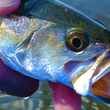
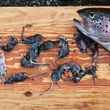





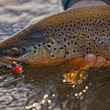



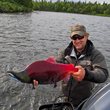
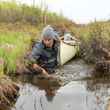



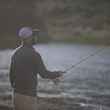




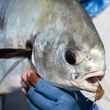
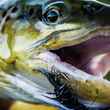


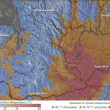
Comments
James E. replied on Permalink
I spent last night fishing the Blue River in Silverthorne Colorado and this article is spot on. It was snowing like crazy and I regularly had to de-ice not just my guides but the rod itself. Totally worth it as I landed 15-20 fish in about 3 hours and some of my biggest rainbow trout of the year. They didn't really take my larger lead flies but instead we're focused on a size 24 olive WD40. Nothing like running downriver with a 4lb rainbow on your 7x tippet. I live winter fly fishing and it might be my favorite time of year to fish. Also fished the Frying Pan yesterday morning and witnessed a great winter midge hatch with 2 hours of rising fish in the snow.
Pages